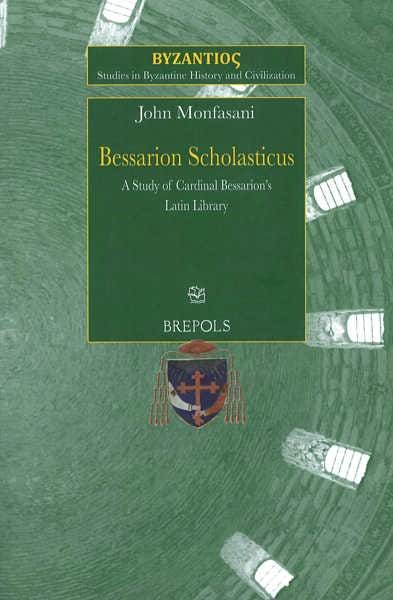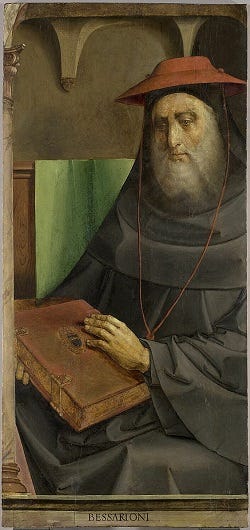Book Review: Cardinal Bessarion’s Latin Library (Monfasani, 2012)
Inside one of the greatest personal libraries ever assembled
Context: In 1468, the Greek Cardinal Bessarion (1403-1472) willed his massive library, of over 1,100 Greek and Latin manuscripts to the Venetian Republic. Forming the basis of Venice’s Bibliotheca Marciana, Bessarion’s gift ensured that his three decades of manuscript collection, copying and commissions would be saved for posterity. Bessarion’s gift constitutes one of the single most important events in the progress of Western Humanism, and indeed, in the preservation of Byzantine manuscripts—including the preservation of important ancient texts that would have otherwise been lost.
Book Review by Christopher Deliso
John Monfasani, ‘Bessarion Scholasticus’: A Study of Cardinal Bessarion’s Latin Library (Brepols, 2012), 306pp.
John Monfasani has long been among the world’s foremost experts on Bessarion and the intellectual history of the Byzantine-Italian transfer of knowledge. He is SUNY-Albany Emeritus Professor of History, and author of many important works (see his webpage here). I have enjoyed his work since 1999, when it provided an invaluable resource, while researching my own MPhil thesis on Bessarion’s teacher, the 15th-century Byzantine philosopher, Georgios Gemistos Plethon (more on the latter another day).
In the current book, Monfasani makes a comprehensive analysis of Bessarion’s Latin-language holdings to develop a profile of the cardinal’s intellectual preferences and relationships, as supported by the evidence. The result is an excellent example of what a scholarly book should be—one that clearly articulates its goals and coverage, and then with quantitative and qualitative research, systematically supports the author’s argument.
Indeed, both in 1999 and now, what I have found most admirable about Monfasani’s exposition is his clarity, precision and lucid style, and a scholarly command of context and focus. This leaves the reader very comfortable in the author’s assured expertise. His monograph is thus both easily understandable for the educated general-interest reader, while also providing a mine of information for specialist scholars.
This is incredibly hard to do, especially in a subject as complicated as Byzantine and Renaissance philology. So, while the text of each page sits atop a veritable mountain of footnotes, and the appendices are longer than the actual chapters, the reader easily follows Monfasani’s straightforward prose and can learn much about an important historical figure. For specialists in the subject and Bessarion himself, this book offers tremendous value for continuing research, as it collects so much specific details about Bessarion, his texts and his circle of colleagues.
Historical Context: Who Was Cardinal Bessarion?
Cardinal Bessarion was one of the foremost clerics and scholars of that transformative era that saw Byzantine learning transferred to Italy, fueling the Humanist interaction with ancient Greek philosophy, science and literature. Along with the slightly earlier Byzantine scholar Manuel Chrysoloras, known mostly for teaching Greek to Italians in Florence from 1397, Bessarion is cited by Monfasani as the most important Byzantine of all in this greater intellectual process.
Bessarion began his career as a Byzantine cleric, and participated in the Byzantine imperial delegation to the Council of Ferrara-Florence (1438-39) that sought to resolve Eastern and Western Christendom’s theological differences, in order to get Western European military aid against the Ottoman Turks who threatened Constantinople. After the council failed, Bessarion became a cardinal in 1440, living the rest of his life in Rome, with legations around Italy and elsewhere in Western Europe. His prestige was such that he was almost elected pope, and he spent the last 14 years of his life as Cardinal Protector of the Franciscan Order, participating in important theological debates.
Bessarion is most famous, however, for his patronage of émigré Byzantine scholars, and his determined efforts to save Greek manuscripts in the years before and after the Ottoman conquest of 1453. He established a veritable academy of scribes, scholars and translators in Rome, and through his broad network of Greek and Latin colleagues played the key role in 15th-century Italy’s interaction with the Byzantine and ancient Greek legacy.
Less well-known, however, is Bessarion’s orientation toward the Latin language, which Monfasani notes he only learned after arriving in Italy. Thus, the current study casts a fascinating light on the cardinal’s literary and theological preferences, and shows how he gradually came to engage with the major Latin-language theologians of the Scholastic tradition (especially, Thomas Aquinas), and thinkers of his day. For this reason, the monograph will also be of value to scholars of Latin and the Italian Renaissance beyond simply Bessarion as a literary personality.
A Note on the Library’s Scale
According to Monfasani, the generous Greek cleric bequeathed to Venice “…a collection of more than 1100 manuscripts and incunabula that became the historic core of the Biblioteca Marciana” (p. 1). The scale of Bessarion’s endowment becomes clearer by understanding just how rare and unsurpassed his library actually was. His personal collection of over 600 Greek manuscripts alone was “….the second-largest of its kind in the Latin West since antiquity” (pp. 2-3).
Importantly, the monograph reveals that even the basic bibliographical scholarship on Bessarion’s library continues to improve nowadays, since the first attempt of Venetian librarians to catalog it began in 1740. For instance, Monfasani adds that Bessarion’s “quite substantial” Latin library is now understood to be fifteen-percent larger than once thought.
Capturing Bessarion’s Personality through his Books
An interesting aspect of Monfasani’s coverage is what it reveals about this last-generation Byzantine scholar and his own self-perception. For the author convincingly shows that Bessarion’s attitudes and intellectual outlook remained essentially Byzantine, despite his acceptance of the Western Church’s dogma and entrance into the Catholic hierarchy after 1439. As the author notes, rumors of Bessarion’s Latinity have been greatly exaggerated:
“Despite all his years in Italy and despite claims by eulogists that he had metamorphosized into a Latin, Bessarion remained a thoroughly Greek humanist, philosopher, and theologian” (p. 27).
This identity is revealed, Monfasani shows, not only by Bessarion’s relatively larger Greek-language library, but also his Latin library. His archaizing proclivities in general, and ownership of specific Latin manuscripts (and very sparse ownership of contemporaneous Humanist authors) affirm that the cardinal’s views remained largely shaped by his former Byzantine Orthodox life and learning, with some modifications for his new situation in the Vatican and with the theological and philosophical debates he would encounter after becoming a cardinal. These debates were in part carried over from Byzantine ones, as with the argument over the relative merits of Plato and Aristotle that had been fought between Plethon and his nemesis, Scholarios.
Indeed, even by the third chapter, when Monfasani discusses Bessarion’s views on Thomas Aquinas, we learn that for a Byzantine of his time, Aquinas was the most-read Latin Scholastic author in Constantinople, specifically because of the comprehensive translations into Greek made by Dimitrios Kydones (died c. 1397). Bessarion owned more manuscripts of Aquinas than of any other Latin author, even Cicero, and used him as a key theological source in his own writing.
Structure of the Work
Three main chapters lie between the Preface and several lengthy appendices. Each chapter is divided into sub-sections, making for clear and neat divisions of content.
Monfasani begins by assessing the quality of the cardinal’s interaction with Humanist texts in the first chapter, ‘Bessarion’s Humanist Library.’ This chapter also studies his list of Latin manuscripts, written by specific profane and then patristic authors, to glean insight on Bessarion’s preferences. After assessing his holdings, Monfasani concludes that Bessarion had little interest in what his contemporaneous Humanist peers were writing; this again indicates a typical archaizing Byzantine mind, seeking exemplars in antiquity and Scholasticism. This also had a practical element, of course; for the Greek émigré to learn the best Latin to use in his own writing, it was only natural that he would turn to the ancient Roman rhetoricians and historians for an example.
In Chapter 2, ‘Bessarion’s Scholastic and Pre-Scholastic Medieval Latin Library,’ the author takes a look at Bessarion’s use of Latin medieval authors to support his theological and philosophical argumentation. Here we learn in detail about Bessarion’s career as a Cardinal Protector, his involvement with various theological disputes, and how his library holdings (and his own Latin writings) reflected his opinion of Latin theology. Monfasani emphasizes the point that the Franciscans and Dominicans were the major theological movements of the time, but also cites many other theological currents and authors of interest to Bessarion, as indicated by his library and correspondence.
Finally, the third chapter covers an intriguing theological topic from a new perspective, and is called ‘The Thomism of Cardinal Bessarion.’ This is arguably the book’s best chapter, for it goes beyond the previous two chapters’ tendency toward quantitative assessment by offering very detailed and specific contextualized arguments that clarify much about Bessarion’s orientation to Thomas Aquinas: that is, how he first became aware of his theology through Greek translations, how he then commented on the differences between Thomas and Duns Scotus, and how he later cited Aquinas extensively in his own work on Plato, in his debate with George of Trebizond. This chapter will be of great interest both to Byzantinists and students of Aquinas, not to mention his reception in the Italian Humanist period.
After these three main chapters, the bulk of the book (too specific for the resent review) is the appendices, which delineate issues like scholastic authors in Bessarion’s library, his listing of the differences between Thomists and Scotists, profane Lain Classical authors in Bessarion’s library, and Latin civil and canon law books in his library. One imagines that for the academic specialists of Bessarion’s world, the book’s chief value lies in these very detailed appendices.
In fact, these appendices are more significant than in most monographs, comprising roughly two-thirds the entire page length. Monfasani even n takes the trouble to try and identify members of Bessarion’s household before 1450, which is a very significant detail considering the number and variety of Greek émigré-scholars (not even counting the Vatican and other Western Humanist personalities he would have known.
Further, Monfasani uses the appendices to provide various authors’ prefaces to some of Bessarion’s own philosophical and theological works; such prefaces amply demonstrate how well-regarded and well-connected was the unlikely Greek cardinal who was among the most learned men of his time.
Conclusion: a Library Analyzed
There is something to this work reminiscent of a story by Borges; I can only imagine the Argentine writer would be fascinated, were he alive to read it. Monfasani’s stated goal is “…to analyze the library for what it can tell us about Bessarion’s intellectual culture, and, more specifically, about his relationship with Latin culture” (p. 2). This study aptly reveals the thinker behind the books, and in lucid fashion explains his likely decision-making in acquiring and using some of his Greek, but especially Latin library. In so doing, Monfasani expands our understanding of Bessarion as a Vatican insider, a theologian, and banished Byzantine, through a manner of study—philology—that is less often conducted, precisely because it is so difficult.
Although I took pages of detailed quotations, I think this is enough to conclude the review for most readers. Let me just note that the science of philology and practice of paleography (the study of manuscripts) is incredibly detailed and difficult work, requiring years of expertise. The mastery of that in itself is rare, but to also encounter a philologist who can write so clearly and make these very complex matters seem simple is just as rare. This is why I appreciate so much the work that John Monfasani has done. He remains an example for the coming generations of scholars in this field to emulate.






As usual, I had no idea. A fascinating portal into a connection between the Roman & Orthodox worlds.
Thanks Chris. I read the Borges story many moons ago. Time to read it again!